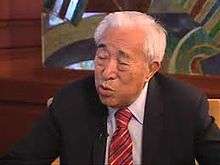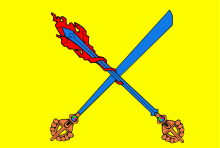CIA Tibetan program
The U.S. Central Intelligence Agency's Tibetan program was a covert operation consisting of political plots, propaganda distribution, as well as paramilitary support and intelligence gathering based on U.S. commitments made to the Dalai Lama in 1951 and 1956.[1]
Although it was formally assigned to the CIA alone, it was nevertheless closely coordinated with several other U.S. government agencies such as the Department of State and the Department of Defense.[2]
Previous operations had aimed to strengthen a number of isolated Tibetan resistance groups, which eventually led to the creation of a paramilitary force on the Nepalese border with approximately 2,000 men. By February 1964, the projected annual cost for all CIA Tibetan operations had exceeded US$1.7 million.[2]
The program was gradually discontinued in the late 1960s, and finally ended with President Nixon's visit to China in 1972.[3]
Overview

In the fields of political action and propaganda, the CIA's Tibetan program was aimed at lessening the influence and capabilities of the Chinese regime.[1] The approval and subsequent endorsement of the program was carried out by the 303 Committee of the United States National Security Council.[5] The program consisted of several clandestine operations with the following code names:
- ST CIRCUS—Cover name for the training of Tibetan guerillas in the island of Saipan, and at Camp Hale in Colorado[6][7][8]
- ST BARNUM—Cover name for the airlifting of CIA agents, military supplies, and support equipment into Tibet.[9][10]
- ST BAILEY—Cover name for a classified propaganda campaign[9]
History
| Timeline |
|---|
 In 1959, the CIA opened a secret facility to train Tibetan recruits at Camp Hale near Leadville, Colorado[3]
 Flag of the Chushi Gangdruk, a prominent Tibetan guerrilla organization backed by the CIA
|
In the early 1950s, the CIA inserted paramilitary teams from the Special Activities Division (SAD) to train and lead Tibetan resistance fighters against the People's Liberation Army of China. These teams selected and then trained Tibetan soldiers in the Rocky Mountains of the United States;[12] as well as at Camp Hale in Colorado.[13][14] The SAD teams then advised and led these commandos against the Chinese, both from Nepal and India. In addition, SAD Paramilitary Officers were responsible for the Dalai Lama's clandestine escape to India, narrowly escaping capture by the Chinese government.[12]
In 1955, a group of local Tibetan leaders secretly plotted an armed uprising, and rebellion broke out in 1956, with the rebels besieging several Chinese government agencies and killing hundreds of Chinese government staff as well as Han Chinese people.[3] By May 1957, a rebel organization with its own fighting force was established with the support of the CIA.[3]
As stated by Palden Wangyal, a veteran guerrilla fighter, the rebels were directly paid by the Americans to attack Chinese government facilities and installations in Tibet:
"Our soldiers attacked Chinese trucks and seized some documents of the Chinese government. After that the Americans increased our pay scale."[15]
Some CIA trainees ended up commanding an army of 2,000 resistance fighters dubbed the Chushi Gangdruk, or "Four Rivers, Six Gorges".[16] These fighters were specialized in ambushing Chinese targets from elevated bases in the mountains of Nepal.[16]
In 1958, with the rebellion in Kham ongoing, two of these fighters, Athar and Lhotse, attempted to meet with the Dalai Lama to determine whether he would cooperate with their activities. However, their request for an audience was refused by the Lord Chamberlain, Phala Thubten Wonden, who believed such a meeting would be impolitic. According to Tsering Shakya, "Phala never told the Dalai Lama or the Kashag of the arrival of Athar and Lhotse. Nor did he inform the Dalai Lama of American willingness to provide aid".[17]
The rebels continued to attack Chinese government officials, disrupting communication lines, and targeting Chinese troops.[3] Following a mass uprising in Lhasa in 1959 during the celebration of the Tibetan New Year and the ensuing Chinese military response, the Dalai Lama went into exile in India.[12]
However, the CIA Tibetan program was gradually discontinued in the late 1960s, and finally ended when Richard Nixon decided to seek rapprochement with China in the early 1970s. As a result, each of the 1,500 CIA-trained rebels received 10,000 rupees to buy land in India or to open a business, instead of fighting the People's Liberation Army of China. In addition, the White House decided that the training of Tibetan guerrillas by the CIA would have to cease, because the risk of damaging Sino-American relations would be too high and costly.[18]
Costs
The following table provides an example of the financial cost of the CIA's Tibetan program in the year 1968 alone:
| Item | Cost |
|---|---|
| Training cost of junior officers | US$45,000[1] |
| Advocacy groups in New York and Geneva | US$75,000[1] |
| Miscellaneous | US$125,000[1] |
| Subsidy to the Dalai Lama | US$180,000[1] |
| Operational costs | US$225,000[1] |
| Covert training site in Colorado | US$400,000[1] |
| Support of 2100 Tibetan guerrillas | US$500,000[1] |
International lobbying
The 14th Dalai Lama was financially backed by the CIA from the late 1950s until 1974, receiving US$180,000 each year. The funds were paid to him personally, although he used most of them for Tibetan government-in-exile activities funding foreign offices to lobby for international support.[19]
Although the Dalai Lama's pleas proved to be less effective with the passing of time, his office in New York did not cease to lobby several U.N. delegations for the Tibetan cause. In addition, the Dalai Lama was also aided by a former U.S. delegate to the U.N.[2]
Criticism
In his 1991 autobiography Freedom in Exile, the 14th Dalai Lama criticized the CIA for supporting the Tibetan independence movement "not because they (the CIA) cared about Tibetan independence, but as part of their worldwide efforts to destabilize all communist governments".[20]
In 1999, the Dalai Lama claimed that the CIA Tibetan program had been harmful for Tibet because it was primarily aimed at serving American interests, and "once the American policy toward China changed, they stopped their help".[3]
See also
References
- 1 2 3 4 5 6 7 8 9 10 11 12 13 "Status Report on Tibetan Operations". Office of the Historian. January 26, 1968.
- 1 2 3 "Status Report on Tibetan Operations". Office of the Historian. January 9, 1968.
- 1 2 3 4 5 6 7 Jonathan Mirsky. "Tibet: The CIA's Cancelled War". The New York Review of Books. Retrieved 3 November 2013.
- ↑ Sautman, Barry (1 March 2010). "Tibet's Putative Statehood and International Law". Chinese Journal of International Law. Oxford University Press. 9 (1): 127–142.
Indeed, after the 1962 war, B.N. Mullik, India's Intelligence Bureau Chief, told Gyalo Thondup, the Dalai Lama's brother and a top CIA asset, that India supported Tibet's “eventual liberation”.
- ↑ Jr, W. Thomas Smith, (2003). Encyclopedia of the Central Intelligence Agency. New York: Infobase Pub. p. 227. ISBN 143813018X.
- ↑ Jehangir Pocha (December 1, 2003). "Tibet's Gamble". In These Times.
The operation, code-named ST CIRCUS, was one of the CIA’s longest-running projects.
- ↑ Lal, Dinesh (2008). Indo-Tibet-China conflict. Delhi: Kalpaz Publications. p. 152. ISBN 8178357143.
- ↑ Johnson, Tim. Tragedy in crimson how the Dalai Lama conquered the world but lost the battle with China. New York: Nation Books. p. 114. ISBN 1568586493.
- 1 2 Roberts, John B. Roberts II, Elizabeth A. (2009). Freeing Tibet 50 years of struggle, resilience, and hope. New York: AMACOM. p. 82. ISBN 0814413757.
- ↑ MERCHET Jean-Dominique (1998). "Livre. Du Viêt-nam à Cuba, l'épopée clandestine des pilotes de la CIA. Les ailes de l'Amérique. Frédéric Lert, "les Ailes de la CIA". Histoire et collections. 512 pp., 145 F." (in French). Libération.
Comme au Tibet, avec l'opération «ST Barnum», de 1957 à 1960. Des avions de transport «civils» franchissent l'Himalaya et s'aventurent sur les hauts plateaux tibétains pour aller parachuter des armes et des hommes à la résistance antichinoise.
- ↑ Roberts, John B. Roberts II, Elizabeth A. (2009). Freeing Tibet 50 years of struggle, resilience, and hope. New York: American Management Association. p. 149. ISBN 9780814413753.
- 1 2 3 Conboy, Kenneth; Morrison, James (2002). The CIA's secret war in Tibet. Lawrence: University Press of Kansas. ISBN 978-0700617883.
- ↑ Roberts, John B; Elizabeth A. Roberts (2009). Freeing Tibet: 50 years of struggle, resilience, and hope. New York, NY: AMACOM Books. p. 43. ISBN 978-0-8144-0983-1. Retrieved 5 March 2012.
- ↑ Dunham, Mikel (2004). Buddha's warriors: the story of the CIA-backed Tibetan freedom fighters, the Chinese invasion, and the ultimate fall of Tibet. New York, NY: Penguin. p. 315. ISBN 978-1-58542-348-4. Retrieved 5 March 2012.
- ↑ McGranahan, Carole (2010). Arrested histories Tibet, the CIA, and memories of a forgotten war. Durham [NC]: Duke University Press. p. 152. ISBN 0822392976.
- 1 2 Paul Salopek (January 26, 1997). "The Cia's Secret War In Tibet". Chicago Tribune.
- ↑ Shakya, Tsering, The dragon in the land of snows : a history of modern Tibet since 1947, London : Pimlico, 1999. ISBN 0-7126-6533-1. Cf. pg. 177
- ↑ Stephen Talty (Dec 31, 2010). "The Dalai Lama's Great Escape". The Daily Beast.
- ↑ Michael Backman. "Behind Dalai Lama's holy cloak". The Age.
- ↑ "CIA Gave Aid to Tibetan Exiles in '60s, Files Show". The Los Angeles Times. Retrieved 8 September 2013.
In his 1990 autobiography, "Freedom in Exile," the Dalai Lama explained that his two brothers made contact with the CIA during a trip to India in 1956. The CIA agreed to help, "not because they cared about Tibetan independence, but as part of their worldwide efforts to destabilize all Communist governments," the Dalai Lama wrote.
